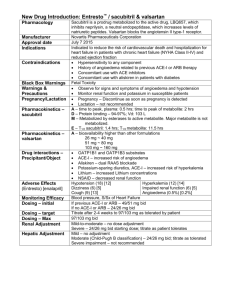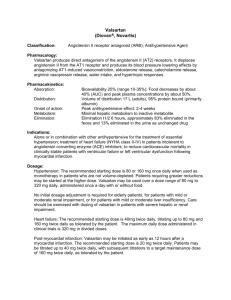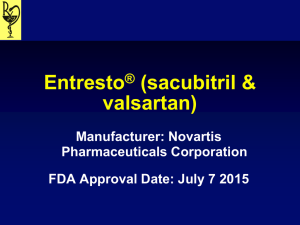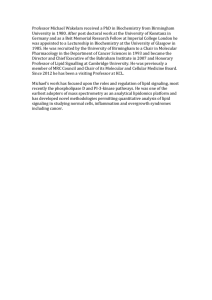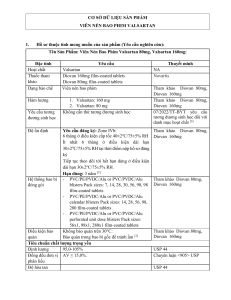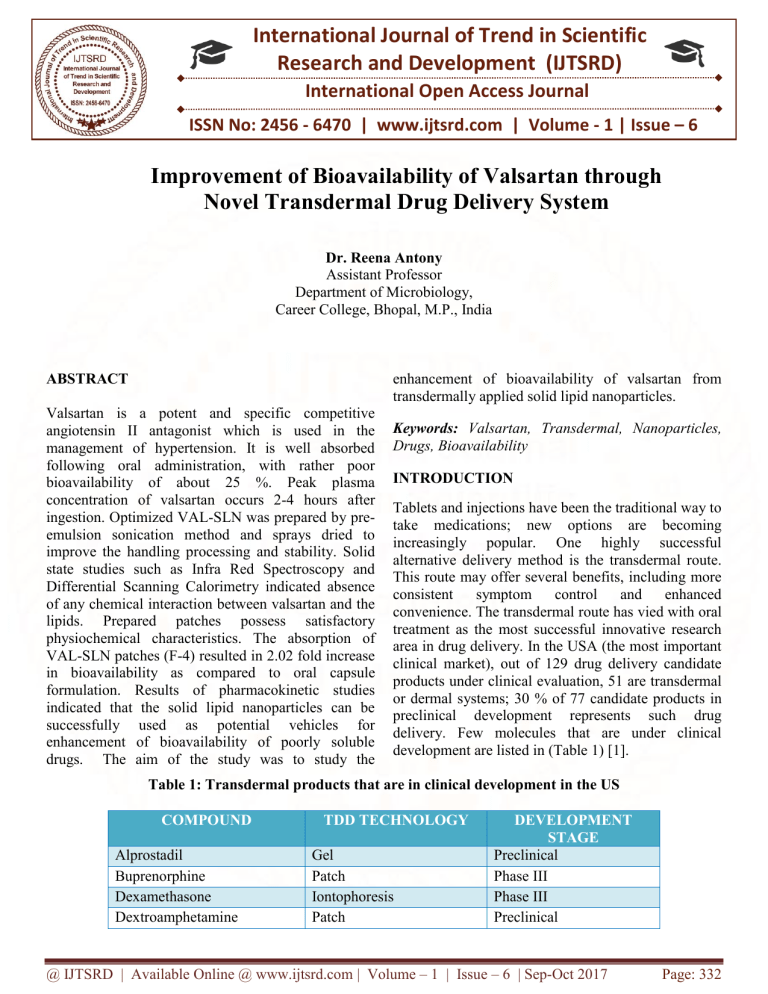
International Journal of Trend in Scientific
Research and Development (IJTSRD)
International Open Access Journal
ISSN No: 2456 - 6470 | www.ijtsrd.com | Volume - 1 | Issue – 6
Improvement of Bioavailability of Valsartan through
Novel Transdermal Drug Delivery System
Dr. Reena Antony
Assistant Professor
Department of Microbiology,
Career College, Bhopal, M.P., India
ABSTRACT
enhancement of bioavailability of valsartan from
transdermally applied solid lipid nanoparticles.
Valsartan is a potent and specific competitive
angiotensin II antagonist which is used in the
management of hypertension. It is well absorbed
following oral administration, with rather poor
bioavailability of about 25 %. Peak plasma
concentration of valsartan occurs 2-4 hours after
ingestion. Optimized VAL-SLN was prepared by preemulsion sonication method and sprays dried to
improve the handling processing and stability. Solid
state studies such as Infra Red Spectroscopy and
Differential Scanning Calorimetry indicated absence
of any chemical interaction between valsartan and the
lipids. Prepared patches possess satisfactory
physiochemical characteristics. The absorption of
VAL-SLN patches (F-4) resulted in 2.02 fold increase
in bioavailability as compared to oral capsule
formulation. Results of pharmacokinetic studies
indicated that the solid lipid nanoparticles can be
successfully used as potential vehicles for
enhancement of bioavailability of poorly soluble
drugs. The aim of the study was to study the
Keywords: Valsartan, Transdermal, Nanoparticles,
Drugs, Bioavailability
INTRODUCTION
Tablets and injections have been the traditional way to
take medications; new options are becoming
increasingly popular. One highly successful
alternative delivery method is the transdermal route.
This route may offer several benefits, including more
consistent
symptom
control
and
enhanced
convenience. The transdermal route has vied with oral
treatment as the most successful innovative research
area in drug delivery. In the USA (the most important
clinical market), out of 129 drug delivery candidate
products under clinical evaluation, 51 are transdermal
or dermal systems; 30 % of 77 candidate products in
preclinical development represents such drug
delivery. Few molecules that are under clinical
development are listed in (Table 1) [1].
Table 1: Transdermal products that are in clinical development in the US
COMPOUND
Alprostadil
Buprenorphine
Dexamethasone
Dextroamphetamine
TDD TECHNOLOGY
Gel
Patch
Iontophoresis
Patch
DEVELOPMENT
STAGE
Preclinical
Phase III
Phase III
Preclinical
@ IJTSRD | Available Online @ www.ijtsrd.com | Volume – 1 | Issue – 6 | Sep-Oct 2017
Page: 332
International Journal of Trend in Scientific Research and Development (IJTSRD) ISSN: 2456-6470
Diclofenac
Dihydrotestosterone
Estradiol
Androgen/Estradiol
Estradiol/Progestin
Testosterone/Estradiol
Fentanyl
Flurbiprofen
Lidocaine
Glucagon-like peptide-1
Methylphenidate
Parathyroid hormone
Rotigotine
Testosterone
Patch
Gel
Gel
Patch
Patch
Patch
Patch, Iontophoresis
Patch
Iontophoresis
Microneedle
Patch
Microneedle
Patch
Gel
Valsartan is a potent and specific competitive
angiotensin II antagonist which is used in the
management of hypertension. Valsartan is a novel and
orally active Ang II antagonist that does not require
hepatic metabolism. It is highly selective antagonist of
Ang II at the AT1-receptor subtype and does not
possess agonist properties. Valsartan is a safe and
well tolerated antihypertensive agent in humans.
Valsartan is well absorbed following oral
administration, with rather poor bioavailability of
about 25 %. Peak plasma concentration of valsartan
occurs 2-4 hours after ingestion. Drug is not
significantly metabolised and is excreted mainly via
the bile as unchanged drug. Valsartan also has pH
dependent solubility whereby, it ranges from very
slightly soluble in an acidic environment to soluble in
a neutral environment of the GI tract. Permeability of
valsartan is low and also pH dependent where it
decreases as environmental pH increases from acidic
to a neutral pH values in GI tract. As a result of these
complex biopharmaceutical properties, development
of a more releasable and bioavailable dosage form of
valsartan with less inter - and intra – subject
variability is challenging [2].
Preclinical
Phase III
Phase III
Phase II
Submitted NDA
Phase III
Preclinical to Phase III
Preclinical
Phase III
Preclinical
Submitted NDA
Preclinical
Phase III
Submitted NDA
• Chemical structure of valsartan.
Fig: 1
• Chemical formula: C24H29N5O3
• Molecular weight: 435.52 g/mol
• Melting point: 105-1100C
• Appearance: white microcrystalline powder
• Water solubility: Practically insoluble in water
Our skin is the largest organ of the human body with a
surface area of approximately 1.5 – 2.0 m2 and an
average thickness of 0.5 mm (ranging from 0.05 mm
to 2 mm). As interface between the body and the
outside world is the skin which fulfils important
protective as well as sensory functions. For the
purpose of transdermal drug delivery, we can examine
the structure and function of human skin categorized
into four main layers.
1. The
innermost
subcutaneous
fat
layer
(hypodermis)
2. The overlying dermis
3. The viable epidermis
4. The outermost layer of the tissue (a non-viable
epidermal layer) the stratum
@ IJTSRD | Available Online @ www.ijtsrd.com | Volume – 1 | Issue – 6 | Sep-Oct 2017
Page: 333
International Journal of Trend in Scientific Research and Development (IJTSRD) ISSN: 2456-6470
1.4) Fundamentals of skin permeations [3]
In old days the skin was supposed to be impermeable with
exception to gases. However, in the last century the study
indicated the permeability to lipid soluble drugs. Also it
was recognized that various layers of skin are not equally
permeable i.e. epidermis is less permeable than dermis.
The transdermal permeation can be visualized as
composite of a series in sequence as:
1. Adsorption of a penetrant molecule onto the surface
layers of stratum corneum.
2. Diffusion through stratum corneum and through
viable epidermis.
3. Finally through the papillary dermis into the
microcirculation.
Materials and Equipment
the concentration. For the preparation of solid lipid
nanoparticles loaded with valsartan, drug should be
completely soluble in lipid. Various lipids such as
Compritol 888 ATO, Glyceryl Monostearate (GMS),
Precirol ATO 5, Gelucire, Emulsire 61 and Stearic
acid were used to study the solubility of drug. Solid
Lipid Nanoparticles (SLN) can be prepared by various
methods.
Pre-optimization studies for formulation of Preemulsion
Pre-optimization studies of pre-emulsion were done
with different concentration of Compritol 888 ATO to
determine optimum percent of Compritol 888 ATO.
Then,
different
surfactants
with
different
concentration were used for initial optimization of
pre-emulsion with optimum lipid concentration (Table
2).
UV spectrophotometric method for analysis of
valsartan was done by regular protocols and the
values of absorbance were plotted graphically against
Table 2: General composition of pre-emulsion during initial studies
Ingredient
Concentration (%)
Drug
Compritol 888 ATO
Oil phase surfactant (Span 60,Soya lecithin)
Aqueous phase surfactant (Poloxamer 188, Tween 80)
1
3-12
2-6
0.5-2
Water
q s to 100 ml
Experimental design
The traditional approach to developing a formulation
is to change 1 variable at a time. By this method it is
difficult to develop an optimized formulation, as the
method reveals nothing about the interactions among
the variables. Hence, a Box-Behnken statistical design
with 3 factors, 3 levels, and 15 runs was selected for
the optimization study. The experimental design
consists of a set of points lying at the midpoint of
each edge and the replicated centre point of the
multidimensional cube [4]. Independent and
dependent variables are listed in (Table 3). The
polynomial equation generated is given below.
Where, Yi is the dependent variable; K is the
intercept; (a-i) are the regression coefficients; and X1,
X2 and X3 are the independent variable that was
selected from the preliminary experiments.
Y = K + aX 1 + bX 2 + cX 3 + dX 1 X 2 + e X 1 X 3
+ f X 2 X 3 + g X 1 X1 + h X 2 X2 + i X 3
X3........................................................................(10)
@ IJTSRD | Available Online @ www.ijtsrd.com | Volume – 1 | Issue – 6 | Sep-Oct 2017
Page: 334
International Journal of Trend in Scientific Research and Development (IJTSRD) ISSN: 2456-6470
Table 3: Variable and their levels in Box-Behnken design
1. Independent
variables
1. Levels
2. Low
3. Medium
4. High
5. Drug:lipid
6. 1:4
7. 1:8
8. 1:12
9. Span 60
10. 2 %
11. 4%
12. 6%
13. Sonication
14. 5
15. 10
16. 15
18. -1
19. 0
20. +1
time(min)
17. Transformed
values
21. Dependent variables
22. Y1= particle size
23. Y2= entrapment efficiency
Preparation of Val-SLN dispersions
Val-SLN was prepared by using pre-emulsion probe
sonication method. The ingredients used and their
levels taken for further study on formulation
optimization of valsartan loaded SLN (VAL-SLN)
dispersions (Table 4).
Table 4: Composition of VAL-SLN dispersion for
detailed studies
Ingredients
Valsartan
Compritol ATO 888
Span 60
Tween 80
Water
Composition (%)
1
4-12
2-6
2
qs to 100 ml
Optimization of preparation of Val-SLN was done by
Design Expert Software (Version 7.1.6, Stat-Ease Inc.
and Minneapolis, MN). Total five optimized
formulations were selected as check points to validate
Response Surface Methodology.
Stability studies
Stability studies on the optimized formulated patches
(F-4) were carried out as per ICH guidelines. Drug
content were used to check the stability of the
formulation after predetermined time. Samples were
withdrawn at the end of 0, 30, 60 and 90 days and
evaluated for Drug content.
RESULTS
Selection of lipid
Selection of lipid was done on the basis of maximum
solubility of valsartan in different lipids and also on
melting point of lipid as the type of drug-lipid matrix
and drug release pattern will depend on it. Out of
different lipids used, valsartan showed maximum
solubility in Compritol ATO 888 (Fig. 2)
Evaluation of VAL-SLN:
Particle size distribution of freshly prepared and
reconstituted spray dried SLNs dispersion in distilled
water was measured by Particle Size Analyzer For
determination of drug entrapment in SLNs, the drug
loaded lipid nanoparticles were separated from free
drug by Ultra-centrifugation. Solid state study were
done by Drug content determination, FTIR study,
DSC study etc
@ IJTSRD | Available Online @ www.ijtsrd.com | Volume – 1 | Issue – 6 | Sep-Oct 2017
Page: 335
amount of lipid in mg added to
solubilize 100 mg of valsartan
International Journal of Trend in Scientific Research and Development (IJTSRD) ISSN: 2456-6470
800
600
400
200
0
lipid
Fig.2: Solubility of valsartan in different lipids
Evaluation of VAL-SLN:
Particle size determination
The particle size analysis of the nanoparticulate
dispersion by laser diffraction using Malvern
Mastersizer showed particle size in the range between
149.3nm to 473 nm. Particle size distribution curve of
optimized sample O4 was 224.32 nm is shown below
(Fig.3).
Fig. 3: Particle size distribution curve of Sample O4
Solid state study
Drug content determination
Drug content of optimized formulations were shown
in following (Table 5)
Table 5: Drug content of optimized formulation
Formulation
Drug content (%)
O-1
97.34±0.8
O-2
98.12±1.2
O-3
98.76±0.5
O-4
99.01±0.2
Data shows mean (n = 3) ± SD
FTIR study
From FTIR study, the characteristic peak of drug such
as ketonic C=O stretch (1602 cm-1), acid C=O stretch
(1726 cm–1), carboxylic group (-COOH stretch) 30003300 cm-1, aromatic and aliphatic (C-H stretch) 29003000 cm-1 disappeared and were replaced by the peak
of Compritol 888 ATO as shown in (Fig. 4) This
established drug entrapment in lipid matrix.
@ IJTSRD | Available Online @ www.ijtsrd.com | Volume – 1 | Issue – 6 | Sep-Oct 2017
Page: 336
International Journal of Trend in Scientific Research and Development (IJTSRD) ISSN: 2456-6470
Fig. 4: FTIR spectra of valsartan (A); compritol ATO 888 bulk (B);
VAL-SLN(C).
Fig. 5: SEM of valsartan loaded solid lipid nanoparticles
Fig. 5: DSC thermograms of bulk compritol ATO 888 (a); pure valsartan (b); VAL-SLN (c)
@ IJTSRD | Available Online @ www.ijtsrd.com | Volume – 1 | Issue – 6 | Sep-Oct 2017
Page: 337
International Journal of Trend in Scientific Research and Development (IJTSRD) ISSN: 2456-6470
Table 6: Drug content during stability studies
Data shows mean (n=3) ± SD
Storage time
One month
Two month
Three month
% drug content
95.12±0.21
94.92±0.14
95.3±0.23
Results of pharmacokinetic studies indicated that the
solid lipid nanoparticles can be successfully used as
potential vehicles for enhancement of bioavailability
of poorly soluble drugs.
CONCLUSION
REFERENCES
Optimized VAL-SLN was prepared by pre-emulsion
sonication method and sprays dried to improve the
handling processing and stability. Transdermal
patches incorporating valsartan loaded solid lipid
nanoparticles (VAL-SLN) and plain valsartan were
prepared by solvent evaporation method using
polymer matrix containing ethyl cellulose (EC) and
polyvinyl pyrrolidone (PVP) in different ratio, of
which PVP:EC (3:2) was selected as relatively best
ratio compare to other with respect to drug release
study and used for further study. Prepared patches
possess satisfactory physiochemical characteristics.
[1] Beverley J. T., Barrie C. F., The transdermal
revolution, Drug Discovery Today, 9 (16),
(2004), 697-703.
[2] Tripathi K.D., Essentials of medical
pharmacology,
Jaypee
brothers,
medical
publisher, Delhi, (2004), 321-322.
[3] Bronaugh R., Maibach H., Percutaneous
Absorption
Drug-Cosmetics-Mechanismrd
Methodology, 3 ed., Marcel Dekker, 101-102.
[4] 45Solanki A. B., Parikh J. R., Formulation and
optimization of piroxicam proniosomes by 3factor, 3-level Box-Behnken design, AAPS
PharmSciTech. 2007; 8(4): Article 86.
@ IJTSRD | Available Online @ www.ijtsrd.com | Volume – 1 | Issue – 6 | Sep-Oct 2017
Page: 338

